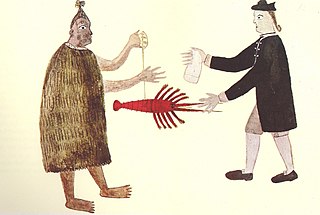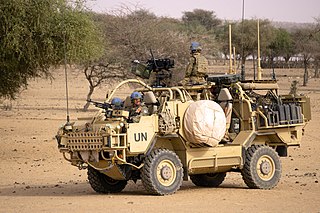
The Netherlands Armed Forces are the military services of the Kingdom of the Netherlands. The core of the armed forces consists of the four service branches: the Royal Netherlands Navy, the Royal Netherlands Army, the Royal Netherlands Air Force and the Royal Netherlands Marechaussee. The service branches are supplemented by various joint support organisations. In addition, local conscript forces exist on the Dutch Caribbean islands of Aruba (AruMil) and Curaçao (CurMil). These operate under the auspices of the Royal Netherlands Navy and the Netherlands Marine Corps. The armed forces are organisationally part of the Ministry of Defence.

The Royal Australian Air Force (RAAF) is the principal aerial warfare force of Australia, a part of the Australian Defence Force (ADF) along with the Royal Australian Navy and the Australian Army. Constitutionally the Governor-General of Australia is the de jure Commander-in-Chief of the Australian Defence Force. The Royal Australian Air Force is commanded by the Chief of Air Force (CAF), who is subordinate to the Chief of the Defence Force (CDF). The CAF is also directly responsible to the Minister for Defence, with the Department of Defence administering the ADF and the Air Force.

His Majesty's Armed Forces (HMAF) is the military of Tonga. It is composed of three operational components and two support elements.

The International Security Assistance Force (ISAF) was a multinational military mission in Afghanistan from 2001 to 2014. It was established by United Nations Security Council Resolution 1386 pursuant to the Bonn Agreement, which outlined the establishment of a permanent Afghan government following the U.S. invasion in October 2001. ISAF's primary goal was to train the Afghan National Security Forces (ANSF) and assist Afghanistan in rebuilding key government institutions; it gradually took part in the broader war in Afghanistan against the Taliban insurgency.

The Regional Assistance Mission to Solomon Islands (RAMSI), also known as Operation Helpem Fren, Operation Anode and Operation Rata, began in 2003 in response to a request for international aid by the Governor-General of Solomon Islands. Helpem Fren means "help a friend" in Solomon Islands Pidgin. The mission officially ended on 30 June 2017.
The military history of Australia spans the nation's 230-year modern history, from the early Australian frontier wars between Aboriginals and Europeans to the ongoing conflicts in Iraq and Afghanistan in the early 21st century. Although this history is short when compared to that of many other nations, Australia has been involved in numerous conflicts and wars, and war and military service have been significant influences on Australian society and national identity, including the Anzac spirit. The relationship between war and Australian society has also been shaped by the enduring themes of Australian strategic culture and the unique security challenges it faces.

The military history of New Zealand is an aspect of the history of New Zealand that spans several hundred years. When first settled by Māori almost a millennium ago, there was much land and resources, but war began to break out as the country's carrying capacity was approached. Initially being fought with close-range weapons of wood and stone, this continued on and off until Europeans arrived, bringing with them new weapons such as muskets. Colonisation by Britain led to the New Zealand Wars in the 19th century in which settler and imperial troops and their Māori allies fought against other Māori and a handful of Pākehā. In the first half of the 20th century, New Zealanders of all races fought alongside Britain in the Boer War and both World Wars. In the second half of the century and into this century the New Zealand Defence Force has provided token assistance to the United States in several conflicts. New Zealand has also contributed troops extensively to multilateral peacekeeping operations.

1st Battalion, Royal Australian Regiment is a regular motorised infantry battalion of the Australian Army. 1 RAR was first formed as the 65th Australian Infantry Battalion of the 34th Brigade (Australia) on Balikpapan in 1945 and since then has been deployed on active service during the Korean War, the Malayan Emergency, the Vietnam War, Unified Task Force in Somalia, East Timor, Iraq War and Afghanistan. Additionally, the battalion has deployed on peacekeeping and other operations to a number of countries including Japan, Rifle Company Butterworth, Timor Leste, Solomon Islands, Tonga and the Philippines. 1 RAR remains one of the Australian Army's most readily deployed units sending individuals and detachments to domestic, regional and other enduring operations. The battalion is currently based in Coral Lines at Lavarack Barracks, Townsville, Queensland, where it forms part of the 3rd Brigade.

The Multi-National Force – Iraq (MNF–I), often referred to as the Coalition forces, was a military command during the 2003 invasion of Iraq and much of the ensuing Iraq War, led by the United States of America, United Kingdom, Australia, Italy, Spain and Poland, responsible for conducting and handling military operations.

1st Civil Affairs Group is a civil affairs (CA) unit of the United States Marine Corps based at Camp Pendleton, California. It is one of three civil affairs units in the Marine Corps, all of which are reserve units. 1st CAG tends to support I Marine Expeditionary Force activities.

Operation Herrick was the codename under which all British operations in the War in Afghanistan were conducted from 2002 to the end of combat operations in 2014. It consisted of the British contribution to the NATO-led International Security Assistance Force (ISAF), and support to the American-led Operation Enduring Freedom (OEF), within the South Asian country.

Following the terrorist attacks of September 11, 2001, several nations took on Al-Qaeda and the Taliban during Operation Enduring Freedom (OEF) in Afghanistan. OEF was the initial combat operations starting on 7 October 2001, in the wake of the 11 September attacks on the United States, and during 2002 and 2003.

Camp Shorabak is a former British Army airbase, located northwest of the city of Lashkargah in Helmand Province, Afghanistan. The camp was situated in a remote desert area, far from population centres.

No. 15 Squadron RAF Regiment is a field squadron of the RAF Regiment in the Royal Air Force. Its mission is protection of RAF bases from ground attack. The squadron's headquarters is at RAF Marham, having moved from RAF Honington.

8th Communication Battalion is a communications battalion in the United States Marine Corps. It is part of the II Marine Expeditionary Force and is headquartered at Marine Corps Base Camp Lejeune, North Carolina.

Australian military involvement in peacekeeping operations has been diverse, and included participation in both United Nations sponsored missions, as well as those as part of ad hoc coalitions. Indeed, Australians have been involved in more conflicts as peacekeepers than as belligerents; however, according to Peter Londey "in comparative international terms, Australia has only been a moderately energetic peacekeeper." Although Australia has had peacekeepers in the field continuously for 60 years – the first occasion being in Indonesia in 1947, when Australians were among the first group of UN military observers – its commitments have generally been limited, consisting of small numbers of high-level and technical support troops or observers and police. David Horner has noted that the pattern changed with the deployment of 600 engineers to Namibia in 1989–90 as the Australian contribution to UNTAG. From the mid-1990s, Australia has been involved in a series of high-profile operations, deploying significantly large units of combat troops in support of a number of missions including those in Cambodia, Rwanda, Somalia and later in East Timor. Australia has been involved in close to 100 separate missions, involving more than 30,000 personnel and 11 Australians have died during these operations.

The September 2012 raid on Camp Bastion was a Taliban raid on Camp Bastion in Afghanistan's Helmand province on the night of 14 September 2012. The base hosted British, American, Danish and Tongan military personnel at the time of the attack. The Taliban fighters killed two U.S. Marines and destroyed or severely damaged eight U.S. Marine Corps AV-8B Harriers and a United States Air Force C-130 before the entire raiding force was killed or captured. The Taliban claimed that the raid was in response to the film, Innocence of Muslims, and have also stated that Prince Harry, who was stationed at the base at the time, was the target of the attack. To replace the aircraft lost in the attack, the USMC deployed 14 Harriers to Afghanistan 36 hours after the raid.
The United Kingdom began a military intervention in Sierra Leone on 7 May 2000 under the codename Operation Palliser. Although small numbers of British personnel had been deployed previously, Palliser was the first large-scale intervention by British forces in the Sierra Leone Civil War. In early May 2000, the Revolutionary United Front (RUF)—one of the main parties to the civil war—advanced on the country's capital, Freetown, prompting the British government to dispatch an "Operational Reconnaissance and Liaison Team" (ORLT) to prepare to evacuate foreign citizens. On 6 May, the RUF blocked the road connecting Freetown to the country's main airport, Lungi. The next day, British soldiers began to secure the airport and other areas essential to an evacuation. The majority of those who wished to leave were evacuated within the first two days of the operation, but many chose to stay following the arrival of British forces.

Operation Newcombe was the code name for two separate and concurrent British non-combat military operations in Mali. One operation involved logistical and airlift support for the French-led Operation Barkhane, whilst the other encompassed peacekeeping in support of the United Nations Multidimensional Integrated Stabilization Mission in Mali (MINUSMA). The operation was first launched on 13 January 2013 by Prime Minister David Cameron and initially involved strategic airlift and aerial reconnaissance. It later saw the deployment of a detachment of Chinook transport helicopters, before shifting its emphasis to UN peacekeeping in 2020. The operation ultimately drew to a close on 14 November 2022 due to political instability in the country.

The 12th Peacekeeping Brigade is a military unit of the Armed Forces of Armenia. Sometimes referred to as the Blue Berets due to its role, it solely specializes in peacekeeping in foreign countries as part of international initiatives. It is commanded by Colonel Arsen Mangasaryan. In early 2016, Defence Minister Seyran Ohanyan said that he considers the brigade to be the "basis for the establishment of a professional army".


















